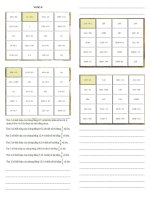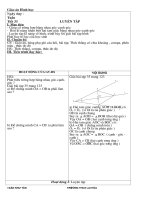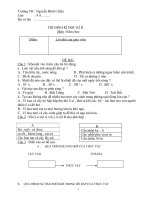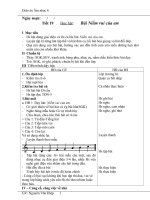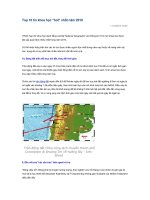Tài liệu Chapter 10 Chemical Bonding II
Bạn đang xem bản rút gọn của tài liệu. Xem và tải ngay bản đầy đủ của tài liệu tại đây (7.95 MB, 154 trang )
Chapter 10
Chemical
Bonding II
2011, NKMB Co., Ltd.
Chemistry, Julia Burdge, 2
st
Ed.
McGraw Hill.
Mr. Truong Minh Chien ;
/>
2
Structure Determines Properties!
•
properties of molecular substances depend on
the structure of the molecule
•
the structure includes many factors, including:
the skeletal arrangement of the atoms
the kind of bonding between the atoms
ionic, polar covalent, or covalent
the shape of the molecule
•
bonding theory should allow you to predict the
shapes of molecules
Chemistry, Julia Burdge, 2
nd
e., McGraw Hill.
3
Molecular Geometry
•
Molecules are 3-dimensional objects
•
We often describe the shape of a molecule
with terms that relate to geometric figures
•
These geometric figures have characteristic
“corners” that indicate the positions of the
surrounding atoms around a central atom in
the center of the geometric figure
•
The geometric figures also have characteristic
angles that we call bond angles
Chemistry, Julia Burdge, 2
nd
e., McGraw Hill.
4
Using Lewis Theory to Predict
Molecular Shapes
•
Lewis theory predicts there are regions of
electrons in an atom based on placing shared
pairs of valence electrons between bonding
nuclei and unshared valence electrons located
on single nuclei
•
this idea can then be extended to predict the
shapes of molecules by realizing these regions
are all negatively charged and should repel
Chemistry, Julia Burdge, 2
nd
e., McGraw Hill.
5
VSEPR Theory
•
electron groups around the central atom will be
most stable when they are as far apart as
possible – we call this valence shell electron
pair repulsion theory
since electrons are negatively charged, they should be
most stable when they are separated as much as
possible
•
the resulting geometric arrangement will allow
us to predict the shapes and bond angles in the
molecule
Chemistry, Julia Burdge, 2
nd
e., McGraw Hill.
6
Chemistry, Julia Burdge, 2
nd
e., McGraw Hill.
7
VSEPR electron domain animation
Chemistry, Julia Burdge, 2
nd
e., McGraw Hill.
8
Electron Groups
•
the Lewis structure predicts the arrangement of valence
electrons around the central atom(s)
•
each lone pair of electrons constitutes one electron group
on a central atom
•
each bond constitutes one electron group on a central
atom
regardless of whether it is single, double, or triple
O N O
•
•
•
•
••
••
••
••
there are 3 electron groups on N
1 lone pair
1 single bond
1 double bond
Chemistry, Julia Burdge, 2
nd
e., McGraw Hill.
9
Molecular Geometries
•
there are 5 basic arrangements of electron groups around
a central atom
based on a maximum of 6 bonding electron groups
though there may be more than 6 on very large atoms, it is very rare
•
each of these 5 basic arrangements results in 5 different
basic molecular shapes
in order for the molecular shape and bond angles to be a
“perfect” geometric figure, all the electron groups must be
bonds and all the bonds must be equivalent
•
for molecules that exhibit resonance, it doesn’t matter
which resonance form you use – the molecular geometry
will be the same
Chemistry, Julia Burdge, 2
nd
e., McGraw Hill.
10
Linear Geometry
•
when there are 2 electron groups around the central
atom, they will occupy positions opposite each other
around the central atom
•
this results in the molecule taking a linear geometry
•
the bond angle is 180°
••••
•
•
•
•
••••
ClBeCl
•
•
•
•
••••
O C O
Chemistry, Julia Burdge, 2
nd
e., McGraw Hill.
11
Linear Geometry
Chemistry, Julia Burdge, 2
nd
e., McGraw Hill.
12
Trigonal Geometry
•
when there are 3 electron groups around the central
atom, they will occupy positions in the shape of a
triangle around the central atom
•
this results in the molecule taking a trigonal planar
geometry
•
the bond angle is 120°
••
•
•
•
•
••••
•
•
•
•
••••
F
F B F
Chemistry, Julia Burdge, 2
nd
e., McGraw Hill.
13
Trigonal Geometry
Chemistry, Julia Burdge, 2
nd
e., McGraw Hill.
14
Not Quite Perfect Geometry
Because the bonds are
not identical, the
observed angles are
slightly different from
ideal.
Chemistry, Julia Burdge, 2
nd
e., McGraw Hill.
15
Chemistry, Julia Burdge, 2
nd
e., McGraw Hill.
16
Tetrahedral Geometry
•
when there are 4 electron groups around the central
atom, they will occupy positions in the shape of a
tetrahedron around the central atom
•
this results in the molecule taking a tetrahedral
geometry
•
the bond angle is 109.5°
••
•
•
•
•
••••
•
•
•
•
••••
•
•
•
•
••
F
F C F
F
Chemistry, Julia Burdge, 2
nd
e., McGraw Hill.
17
Tetrahedral Geometry
Chemistry, Julia Burdge, 2
nd
e., McGraw Hill.
18
Methane
Chemistry, Julia Burdge, 2
nd
e., McGraw Hill.
19
Trigonal Bipyramidal Geometry
•
when there are 5 electron groups around the central atom, they
will occupy positions in the shape of a two tetrahedra that are
base-to-base with the central atom in the center of the shared
bases
• this results in the molecule taking a trigonal bipyramidal
geometry
•
the positions above and below the central atom are called the
axial positions
•
the positions in the same base plane as the central atom are
called the equatorial positions
•
the bond angle between equatorial positions is 120°
•
the bond angle between axial and equatorial positions is 90°
Chemistry, Julia Burdge, 2
nd
e., McGraw Hill.
20
Trigonal Bipyramid
Chemistry, Julia Burdge, 2
nd
e., McGraw Hill.
21
Trigonal Bipyramidal Geometry
P
Cl
Cl
ClCl
Cl
•
•
•
•
•
•
•
•
•
•
•
•
••
••
••
••
••
••
••
••
••
Chemistry, Julia Burdge, 2
nd
e., McGraw Hill.
22
Chemistry, Julia Burdge, 2
nd
e., McGraw Hill.
23
Octahedral Geometry
•
when there are 6 electron groups around the central
atom, they will occupy positions in the shape of two
square-base pyramids that are base-to-base with the
central atom in the center of the shared bases
•
this results in the molecule taking an octahedral
geometry
it is called octahedral because the geometric figure has 8
sides
•
all positions are equivalent
•
the bond angle is 90°
Chemistry, Julia Burdge, 2
nd
e., McGraw Hill.
24
Octahedral Geometry
Chemistry, Julia Burdge, 2
nd
e., McGraw Hill.
25
Octahedral Geometry
S
F
F
F
F
F
F
•
•
•
•
•
•
•
•
•
•
•
•
•
•
•
•
••
••
••
••
••
••
••
••
••
••
Chemistry, Julia Burdge, 2
nd
e., McGraw Hill.

